Jeep Cherokee (XJ): Description and operation
DESCRIPTION The cooling system regulates engine operating temperature.
It allows the engine to reach normal operating
temperature as quickly as possible, maintains
normal operating temperature and prevents overheating.
The cooling system also provides a means of heating
the passenger compartment and cooling the automatic
transmission fluid (if equipped). The cooling
system is pressurized and uses a centrifugal water
pump to circulate coolant throughout the system.
An optional factory installed heavy duty cooling
package is available on most models. The package
consists of a radiator that has an increased number
of cooling fins. Vehicles equipped with a 2.5L/4.0L
engine and heavy duty cooling and/or air conditioning
also have an auxiliary electric cooling fan.
The cooling system consists of: Cooling system circulation for 2.5L/4.0L models is
shown in (Fig. 1).
1 - HEATER CORE DESCRIPTION All models equipped with an automatic transmission
are equipped with a transmission oil cooler
mounted internally within the radiator tank. This
internal cooler is supplied as standard equipment on
all models equipped with an automatic transmission.
Transmission oil is cooled when it passes through
this separate cooler. In case of a leak in the internal
radiator mounted transmission oil cooler, engine coolant
may become mixed with transmission fluid or
transmission fluid may enter engine cooling system.
Both cooling system and transmission should be
drained and inspected if the internal radiator
mounted transmission cooler is leaking.
An auxiliary air-to-oil transmission oil cooler is
available with most engine packages.
The auxiliary air-to-oil transmission oil cooler is
located in front of the radiator or A/C condenser (if
equipped) and behind the grill. It is mounted to the
front frame crossmember.
The auxiliary oil coolers on all models operate in
conjunction with the internal radiator mounted main
oil cooler. The transmission oil is routed through the
main cooler first, then the auxiliary cooler, before
returning to the transmission.
1 - AUXILIARY TRANSMISSION OIL COOLER DESCRIPTION The system works along with the radiator pressure
cap. This is done by using thermal expansion and
contraction of the coolant to keep the coolant free of
trapped air. It provides: The coolant reserve/overflow system consists of a
radiator mounted pressurized cap, a plastic reserve/
overflow tank (Fig. 3) (Fig. 4), a tube (hose) connecting
the radiator and tank, and an overflow tube on
the side of the tank.
1 - COOLANT RESERVE/OVERFLOW TANK OPERATION As the engine cools, a vacuum is formed in the
cooling system of both the radiator and engine. Coolant
will then be drawn from the coolant tank and
returned to a proper level in the radiator. DESCRIPTION All models are equipped with a viscous fan. This
thermal viscous fan drive is a torque-and-temperature-
sensitive clutch unit. It automatically increases
or decreases fan speed to provide proper engine cooling.
Vehicles with a 2.5L/4.0L engine with air conditioning,
or 4.0L with "max" cooling also have an
auxiliary electrical cooling fan.
1 - CLAMP
1 - VISCOUS FAN DRIVE DESCRIPTION WARNING: DO NOT OPERATE ENGINE UNLESS
BLOCK HEATER CORD HAS BEEN DISCONNECTED
FROM POWER SOURCE AND SECURED IN PLACE.
An optional engine block heater is available for all
models. The heater is equipped with a power cord.
The cord is attached to an engine compartment component
with tie-straps. The heater warms the engine
providing easier engine starting and faster warm-up
in low temperatures. The heater is mounted in a core
hole of the engine cylinder block (in place of a freeze
plug) with the heating element immersed in engine
coolant. BLOCK HEATER SPECIFICATIONS
1 - BLOCK HEATER OPERATION Connecting the power cord to a grounded 110-120
volt AC electrical outlet with a grounded, three-wire
extension cord activates the block heater. DESCRIPTION CAUTION: Do not operate an engine without a thermostat,
except for servicing or testing.
A pellet-type thermostat controls the operating
temperature of the engine by controlling the amount
of coolant flow to the radiator. On all engines the
thermostat is closed below 195F (90C). Above this
temperature, coolant is allowed to flow to the radiator.
This provides quick engine warm-up and overall
temperature control.
An arrow plus the word UP is stamped on the
front flange next to the air bleed. The words TO
RAD are stamped on one arm of the thermostat.
They indicate the proper installed position.
The same thermostat is used for winter and summer
seasons. An engine should not be operated without
a thermostat, except for servicing or testing.
Operating without a thermostat causes other problems.
These are: A 'check engine' light and a DTC
will eventually be set, longer engine warm-up time,
unreliable warm-up performance, increased exhaust
emissions and crankcase condensation. This condensation
can result in sludge formation.
1 - LONG BOLT DESCRIPTION CAUTION: Plastic tanks, while stronger than brass,
are subject to damage by impact, such as
wrenches.
Radiators for both engines are the cross flow type.
Plastic tanks are used on all radiators.
1 - RADIATOR DESCRIPTION All radiators are equipped with a pressure cap.
This cap releases pressure at some point within a
range of 83-110 kPa (12-16 psi). The pressure relief
point (in pounds) is engraved on top of the cap (Fig.
9).
The cooling system will operate at pressures
slightly above atmospheric pressure. This results in a
higher coolant boiling point allowing increased radiator
cooling capacity. The cap contains a springloaded
pressure relief valve that opens when system
pressure reaches release range of 83-110 kPa (12-16
psi).
A rubber gasket seals radiator filler neck. This is
done to maintain vacuum during coolant cool-down
and to prevent leakage when system is under pressure
1 - FILLER NECK SEAL OPERATION A vent valve in the center of cap allows a small
coolant flow through cap when coolant is below boiling
temperature. The valve is completely closed when
boiling point is reached. As the coolant cools, it contracts
and creates a vacuum in the cooling system.
This causes the vacuum valve to open and coolant in
the reserve/overflow tank to be drawn through its
connecting hose into radiator. If the vacuum valve is
stuck shut, the radiator hoses will collapse on cooldown. DESCRIPTION CAUTION: All engines are equipped with a reverse
(counter-clockwise) rotating water pump and viscous
fan drive assembly. REVERSE is stamped or
imprinted on the cover of the viscous fan drive and
inner side of the fan. The letter R is stamped into
the back of the water pump impeller (Fig. 10).
A centrifugal water pump circulates coolant
through the water jackets, passages, intake manifold,
radiator core, cooling system hoses and heater core.
The pump is driven from the engine crankshaft by a
drive belt on all engines.
The water pump impeller is pressed onto the rear
of a shaft that rotates in bearings pressed into the
housing. The housing has a small hole to allow seepage
to escape. The water pump seals are lubricated
by the antifreeze in the coolant mixture. No additional
lubrication is necessary.
1 - R STAMPED INTO IMPELLER DESCRIPTION The cooling system utilizes both worm drive and
spring type hose clamps. If a spring type clamp
replacement is necessary, replace with the original
Mopart equipment spring type clamp.
CAUTION: A number or letter is stamped into the
tongue of constant tension clamps. If replacement
is necessary, use only a original equipment clamp
with matching number or letter (Fig. 11).
1 - SPRING CLAMP SIZE LOCATION OPERATION The worm type hose clamp uses a specified torque
value to maintain proper tension on a hose connection.
The spring type hose clamp applies constant tension
on a hose connection. To remove a spring type
hose clamp, use Special Tool 6094 or equivalent, constant
tension clamp pliers (Fig. 12) to compress the
hose clamp.
1 - HOSE CLAMP TOOL 6094 DESCRIPTION CAUTION: Engines equipped with poly-V drive
belts have reverse rotating fans and viscous fan
drives. They are marked with the word REVERSE to
designate their usage. Installation of the wrong fan
or viscous fan drive can result in engine overheating.
The thermal viscous fan drive is a silicone-fluidfilled
coupling used to connect the fan blades to
either the engine or the water pump shaft. The coupling
allows the fan to be driven in a normal manner.
This is done at low engine speeds while limiting the
top speed of the fan to a predetermined maximum
level at higher engine speeds.
2.5L vehicles with A/C are equipped with a viscous
fan drive which is designed to "free wheel" during
most of the ambient conditions encountered by the
vehicle and will only engage during high heat loads
as seen in trailer towing or high ambient temperatures.
A thermostatic bimetallic spring coil is located on
the front face of the viscous fan drive unit. A typical
viscous unit is shown in (Fig. 13). This spring coil
reacts to the temperature of the radiator discharge
air. It engages the viscous fan drive for higher fan
speed if the air temperature from the radiator rises
above a certain point. Until additional engine cooling
is necessary, the fan will remain at a reduced rpm
regardless of engine speed.
Vehicles equipped with 2.5L engines have what is
know as an hybrid cooling fan system. This means
that not only do they have a viscous fan but they also
have an electric fan as well. The hybrid viscous fan
drive has a low speed characteristic. This causes the
mechanical fan speeds to be very low 200-400 rpm
range when not engaged allowing the engine to have
additional performance and horsepower gaines.
1 - VISCOUS FAN DRIVE OPERATION Only when sufficient heat is present, will the viscous
fan drive engage. This is when the air flowing
through the radiator core causes a reaction to the
bimetallic coil. It then increases fan speed to provide
the necessary additional engine cooling.
Once the engine has cooled, the radiator discharge
temperature will drop. The bimetallic coil again
reacts and the fan speed is reduced to the previous
disengaged speed. DESCRIPTION Vehicles equipped with a 2.5L/4.0L engine and air
conditioning and 4.0L vehicles equipped with the
"max" cooling package also have an electrical cooling
fan. The fan is controlled by the cooling fan relay,
which is located in the power distribution center
(PDC) (Fig. 15). For the location of relay within the
PDC, refer to the label on PDC cover.
The electric fan on the 2.5L engine equipped vehicles
is considered the primary fan (low to moderate
ambient conditions) and is energized when the JTEC
receives input from the coolant temperature sensor
or the a/c system and supplies ground to the cooling
fan relay.
The cooling fan motor is protected by a 40 amp
maxi-fuse located in the PDC. The fan relay is protected
by a 15 amp fuse located in the junction block. OPERATION Electric cooling fan 2.5L: When air conditioning
is not requested, the electric fan will not come on
unless the coolant temperature is at least 103 C
(218 F), at which time the fan will come on and
remain on until the coolant temperature drops to 99
C (210 F) or below. When air conditioning is
requested (including defroster operation), the fan will
cycle on and off in conjunction with the A/C compressor
unless the coolant temperature is at least 97 C
(207 F), at which time the fan will come on and
remain on until the coolant temperature drops to 93
C (199 F) or below. Then, the cycle fan operation
will resume. When the fan is scheduled to be on, the
powertrain control module (PCM) provides a ground
path for the fan relay. This ground is provided to the
cooling fan relay through pin C2 of PCM connector
C3. Battery voltage is then applied to the fan
through the relay. When the fan is scheduled to be
off, the PCM opens the ground path to the relay. This
will prevent the cooling fan from being energized.
1 - (LHD)
1 - RIGHT FENDER Electric cooling fan 4.0L: With or without A/C
request the electric fan will come on only when the
coolant temperature is at least 106 C (223 F), and
will remain on until the coolant temperature drops to
103 C (217 F) or below. Regardless of coolant temperature,
When air conditioning system pressures
reach 2068.5 6 138 kPa (300 6 20 psi) the electric
fan will engage and continue to run until the A/C
system pressure drops to 1620.3 kPa (235 psi) minimum,
then the electric fan will shut off.Cooling system
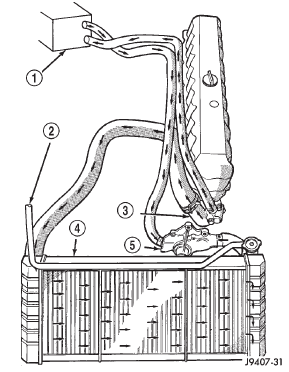
Fig. 1 Coolant Circulation-2.5L/4.0L Engines
2 - TO COOLANT RESERVE/OVERFLOW TANK
3 - THERMOSTAT HOUSING
4 - RADIATOR
5 - WATER PUMPAutomatic transmission oil cooler
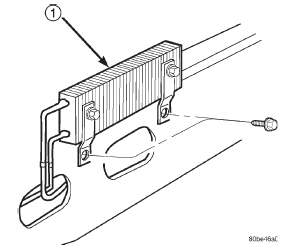
Fig. 2 Auxiliary Transmission Oil CoolerCoolant reserve/overflow system
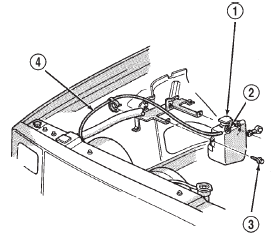
Fig. 3 Reserve/Overflow Tank-Except Right Hand Drive
2 - CLAMP
3 - MOUNTING BOLTS
4 - TUBE TO RADIATORCooling system fans
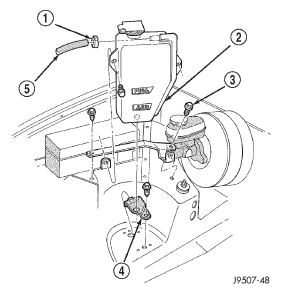
Fig. 4 Reserve/Overflow Tank-With Right Hand Drive
2 - COOLANT RESERVE/OVERFLOW TANK
3 - MOUNTING BOLTS
4 - LOWER BRACKET
5 - TUBE TO RADIATOR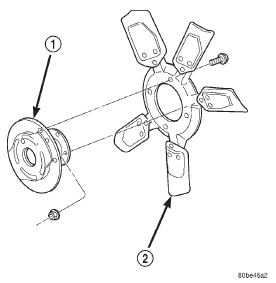
Fig. 5 Viscous Fan Drive and Fan Blade Assembly
2 - FAN BLADE ASSEMBLYBlock heater
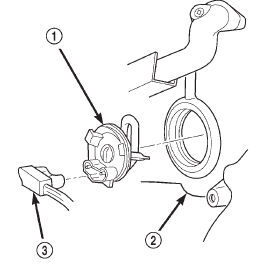
Fig. 6 Engine Block Heater
2 - CYLINDER BLOCK
3 - BLOCK HEATER POWER CORDThermostat
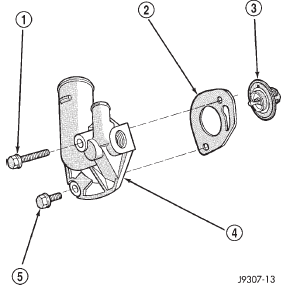
Fig. 7 Thermostat and Housing
2 - GASKET
3 - THERMOSTAT
4 - THERMOSTAT HOUSING
5 - SHORT BOLTRadiator
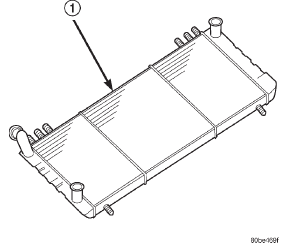
Fig. 8 Cross Flow RadiatorRadiator pressure cap
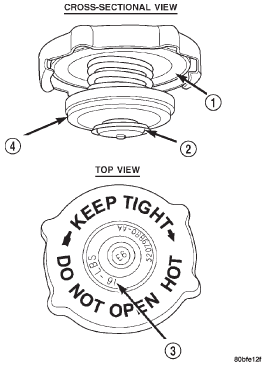
Fig. 9 Radiator Pressure Cap and Filler Neck-Typical
2 - VACUUM VENT VALVE
3 - PRESSURE RATING
4 - PRESSURE VALVEWater pump
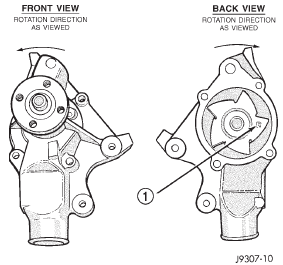
Fig. 10 Reverse Rotating Water Pump-TypicalHose clamps
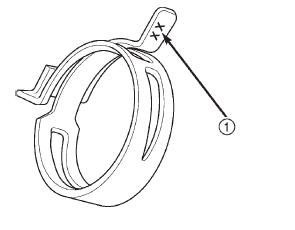
Fig. 11 Spring Clamp Size Location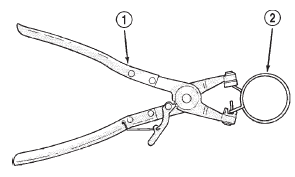
Fig. 12 Hose Clamp Tool
2 - HOSE CLAMPViscous fan drive
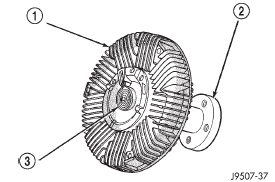
Fig. 13 Typical Viscous Fan Drive
2 - MOUNTING HUB
3 - THERMOSTATIC SPRINGElectric cooling fan
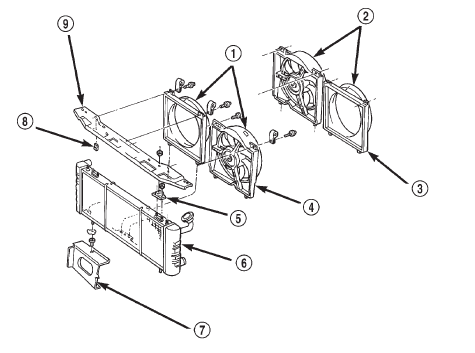
Fig. 14 Electric Cooling Fan
2 - (RHD)
3 - VISCOUS FAN SHROUD
4 - ELECTRIC FAN MODULE
5 - ISOLATOR
6 - RADIATOR
7 - LOWER CROSSMEMBER
8 - U-NUT
9 - UPPER CROSSMEMBER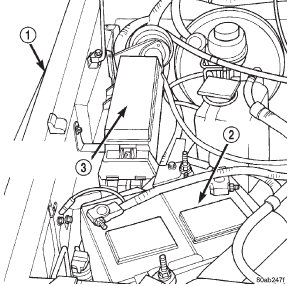
Fig. 15 Power Distribution Center (PDC)
2 - BATTERY
3 - POWER DISTRIBUTION CENTER
Other materials:
Service procedures
BODY LUBRICATION
All mechanisms and linkages should be lubricated
when necessary. This will maintain ease of operation
and provide protection against rust and excessive
wear. The weatherstrip seals should be lubricated to
prolong their life as well as to improve door sealing.
All applicable ...


